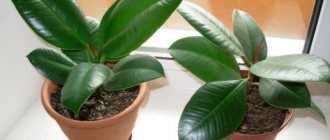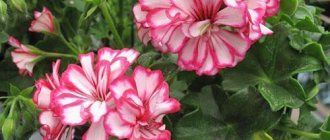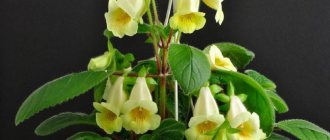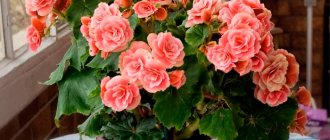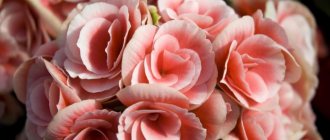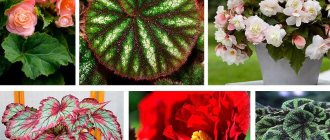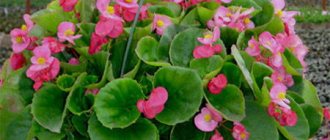In today's episode:
Good afternoon, dear guests of my blog.
Finally, I got around to this article, in which I will talk about my experience in rooting the capricious Elatior Borias.
And although at first I did not plan to somehow make my experiment public, it turned out to be quite interesting, and the results surprised me.
Therefore, I decided to show what I did, perhaps my experience will be useful to someone.
My fascination with these begonias began when I accidentally came across a photo of the Elatior Borias begonia on the Internet.
I was simply amazed by her beauty. And as an experienced maniac gardener, I scoured all the collectors’ forums, pages on social networks, Avito, online stores for the sale of this plant in my city.
I was interested in already domesticated cuttings. I had read about how difficult it is for Dutch store-bought begonias to take root, and I didn’t want to mess with them.
Unfortunately, I was unable to purchase a homemade cutting. And the stars coincided so well that when I found myself in the shopping center on completely different, non-flower matters, I saw him...
It stood on the counter of the flower department and looked stunning!
Mentally, I immediately christened him Boriska and promised him that today he would be standing at my house.
I had to slow down my husband, who was briskly dragging me past, into the grocery department, and tell him that I wanted this Boris.
My husband almost slipped, I was drooling so much at the sight of this masterpiece of nature and selection, followed the direction of my gaze, and understood me correctly.
The price tag of 500 rubles caused a slight sadness in his eyes, and he probably thought that I was a witch, because I always manage to find a place for a new flower on our windowsills, where you can’t even insert a finger between the pots.
But my husband has moments of enlightenment when it is extremely difficult for him to refuse me. And a couple of minutes later Borias was in my tenacious hands and was on his way to his new place of residence.
Description of the flower
A hybrid species of the Begoniaceae family, obtained by crossing tuberous and Socotrans begonias. The height of the bush reaches 40 cm and is characterized by fleshy stems and glossy leaves in the shape of an asymmetrical heart with jagged edges of a characteristic color (the top is glossy green, the bottom is matte salad green with pronounced veins).
During flowering, the plant is covered with bright inflorescences of rich, rich shades on thin peduncles growing from the axils of the leaves. The diameter of the flower is about 5 cm. The flowering period of Elatior begonia is from the beginning of summer to the end of winter, which is why it received its second name - winter begonia. You can read about other types of flowering begonias and the features of their cultivation in a separate article.
Reference! This hybrid was bred in 1883 by the English gardener Z. Veitch.
About the plant
The plant is a perennial shrub, of a hybrid type. The maximum height reaches no more than 40cm. The stem is strong and fleshy. Flowers are usually up to 8 cm in diameter, collected in inflorescences. They are placed on long peduncles.
The color of the petals varies, depending on the variety. The texture of the inflorescences is terry and smooth. The type of flowers resembles a little inflorescence of roses and peonies. The leaves have an asymmetrical, heart-shaped shape.
Their color is dark green with a glossy sheen; underneath they are light green. The main feature of this species is flowering in the cold season , for this quality the plant is given the second name “winter”.
How to propagate at home?
Cuttings
Propagation by cuttings is one of the most popular methods of propagation, as it allows you to preserve all the characteristics of the mother plant and gives quick results. Cuttings of begonia Elatior are carried out in the spring-summer period, when the plant is in the active growing season, and weather conditions contribute to the rapid and effective rooting of shoots.
Some gardeners believe that cuttings rooted in summer will produce too squat, low-growing bushes that bloom too quickly, preventing the plant from fully growing.
Preparation of cuttings
- It is necessary to select healthy, without visible damage, apical cuttings 8–10 cm long, each one must have a pair of leaves and 2–3 axillary buds.
- They should be cut from the mother plant with a sharp, disinfected knife or pruning shears at an angle of 45 degrees.
- It is recommended to air dry the petiole a little, and before rooting, dip its tip in a root formation stimulator.
Another option is also allowed: cut cuttings are left overnight in a Heteroauxin solution.
How to root?
The best option for rooting Elatior begonia is to place the cutting not in soil or water, but directly in vermiculite, perlite or pure sphagnum. All of these substances have some antibacterial properties.
It is better to use a small transparent container as a pot for rooting cuttings : this will make it easier to observe the development of roots and the condition of the soil. You can use ordinary plastic cups for these purposes, but do not forget to make holes in them to drain excess water, and the bottom layer should be drainage and consist of expanded clay or brick chips, pieces of foam.
- The cut and dried petiole is dipped with the tip into water, and then into a root formation stimulator, for example, “Kornevin”.
- Next, the shoot is buried at an angle into moist vermiculite by 2–3 cm. Rooting will be more likely to succeed if the top of the pot is covered with a jar or plastic bag, while not forgetting to open the bag or jar daily to ventilate the seedling and systematically moisten the soil.
- With the appearance of the first roots (in 2 - 2.5 weeks), the “greenhouse” can be removed.
Planting in the soil
As soon as the roots become stronger, the begonia can be planted in individual pots with a diameter of 7–9 cm, which are filled with a substrate consisting of purchased soil, perlite and vermiculite in equal proportions.
The best planting method for young seedlings rooting in the ground is the transshipment method:
- The plant is taken out of the container and, without shaking off the soil clod, is placed in a new pot.
- The top layer of soil near the stem is pressed down with your hands, the plant is watered and put in its place.
- When the plant reaches a height of 12–15 cm, it is necessary to pinch the top leaf to form a decorative crown of the plant.
Attention! In begonia Elatior, the development of flower stalks can be stimulated: the plant receives light for 9 hours, the rest of the time the sprouts are covered with a black bag. This regime must be followed for 10 - 14 days. As a result of such manipulations, flowering can be expected within 2 to 3 months.
We invite you to watch a video about the propagation of Elatior begonia by cuttings and leaves:
Seeds
Since Elatior begonia is a hybrid, it is extremely difficult to propagate it at home. It is not possible to collect seed material on your own. But if you managed to buy seeds in a store, then you can sow them in February - March, so that by the beginning of summer the plant produces its first buds.
A suitable container is a container with holes in the bottom and a drainage layer . It is better to buy soil; it should be watered generously a day before sowing.
- The seeds are evenly distributed over the surface, covered with glass or film on top, not forgetting about daily ventilation of the crops. The required temperature in the room with containers is + 22C – +25C. The place in which the box with seedlings is located should be well lit, but without direct sunlight.
- After the seedlings appear and grow stronger, the coating can be removed.
- When the seedlings have formed 2 - 3 leaves, it is necessary to pick them, planting them 2 - 3 cm from each other.
- After a month or two, re-picking is carried out: the distance between the seedlings should be 5 – 6 cm.
- And only in May, with the establishment of warm weather, young shoots are planted in individual pots.
Read more about propagating ever-flowering begonia by seeds and cuttings in this article.
Reference! Planting plant seedlings from common containers into individual containers is traditionally called planting. In this case, the final part of the taproot must be removed during this planting. This is done in order to stimulate branching of the root system.
Further care
The tropical beauty requires special conditions, it is often subject to stress, and the development process directly depends on the surrounding parameters. To get good results when growing begonias, you should pay attention to the following nuances:
The optimal temperature and humidity conditions in the room should be at +22-26°C, humidity 70%.- Begonia Elatior prefers diffused sunlight.
- Moderate moisture, do not flood the plant with water. You need to water again when the top layer of soil dries well. Do not spray the plant under any circumstances, otherwise this may lead to the development of fungal diseases.
- During the flowering period, it is important to feed the flower with fertilizers high in potassium and phosphorus. During the active growth phase, fertilize with nitrogen minerals, but in moderation.
- In winter, the air temperature should be maintained at no lower than +18°C, with minimal watering.
- As the plant grows, it should be pinched so that the bush has a neat shape and compact size. Remove the top shoots from the crowns. Removing the lower leaves helps to ventilate the root zone of the flower.
- As necessary, you should pick off dried flowers, loosen the soil, spray, remove dust from the foliage, and inspect the plant for pests.
Find out more details about how to care for Elatior begonias so that they will delight you with their flowering even in winter.
Begonia is represented by a wide variety of species. On our website we have prepared a number of articles with detailed descriptions and useful tips on planting and caring for some of the flower varieties, such as: Bolivian, Collared, Griffith, Diadema, Smaragdovaya, Sizolistnaya, Tiger, Hogweed, Metallic.
Propagating and growing Elatior begonia at home is not so difficult. The main thing is to stick to the basic rules at first, and with experience everything will go like clockwork. And the most beautiful, charming flowers will bloom in your house.
Possible problems
- Rotting of cuttings . This phenomenon is possible with excessive watering and irrigation. Also, one should not forget about daily ventilation of the “greenhouses” in which the plant is rooted.
- The seeds do not germinate . This is possible if the seed was of poor quality or had been lying around for a long time. It is necessary to check the expiration date of seeds purchased in the store. Dry soil and low room temperature can also cause this phenomenon. The solution is to moisten the soil in the container, raise the temperature to +22C - +25C.
- The shoots are too long and thin . They clearly don't have enough light. The container with seedlings must be moved closer to the light source.
- Slow growth . The seedling lacks nutrients and needs to be fed.
You will find additional information about ever-flowering begonia varieties in separate articles on the pages of our website. Read:
- Basic rules for caring for ever-flowering begonia at home.
- Magnificent double ever-blooming begonia.
Diseases and pests
Maintenance errors, primarily stagnation or lack of moisture in the soil, weaken the plant and provoke its defeat by powdery mildew . In this case, you need to optimize watering and treat the begonia with fungicides.
The combination of high humidity and low temperature leads to the development of root or leaf rot . If the process has just begun, you should urgently optimize the temperature and humidity conditions and remove damaged parts. In case of severe damage, you will have to root cuttings cut from healthy shoots and keep them in appropriate conditions, and get rid of the rest of the plant.
Begonia can be attacked by spider mites, aphids, scale insects, thrips and mealybugs . As a first measure, insects are removed using a cotton swab dipped in alcohol or treated with a soap solution. The most effective pest control is systemic insecticides.
Begonia elatior is a beautiful hybrid of two geographically distant “parents” - it is exclusively decorative during the period of abundant long flowering, which also extends into winter. At the end of this flower “fireworks”, having neither tuberous nor bulbous “reserve of strength”, the plant most often takes a long time to come to its senses.
Begonia Elatior propagation by cuttings
Such an unusually beautiful plant as begonia can be propagated in three ways: rhizomes, cuttings and seeds. However, cuttings are considered the preferred method, since it allows you to completely preserve all the characteristics of the variety, including the palette of shades and terry, which is often not possible when propagating by other methods.
How is Beonia Elatior propagated by cuttings?
In most cases, begonia propagation is not very different from the begonia species, so begonia elatior reproduces like 95% of all begonia species. It has been noticed that when planted by cuttings, begonia begins to bloom much earlier than when using other methods. It is important not to cover the top of the plant with soil, so as not to destroy the flower.
Soil selection
Begonias love loose soil with low acidity. The soil should be as saturated with nutrients as possible, so it is better to purchase it in a specialized store. If you prepare the soil manually, sterilize it before planting indoor exotics.
This is necessary to exclude the presence of pathogenic bacteria. It is important that the soil is moderately moist. Begonia categorically does not tolerate waterlogging, this leads to rotting of the roots.
Photo: Before planting begonia, the soil must be saturated with nutrients



